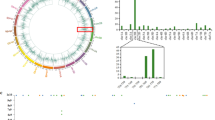Abstract
A set of cultivars used as genitors in apricot breeding programs aimed at introducing sharka resistance were examined by AFLP molecular marker analysis. The markers obtained indicated that apricot cultivars resistant to sharka were related to the European cultivars, but they potentially share a common ancestor donor of sharka outside of the European group. Segregation of AFLP and RAPD markers has been tested in two progenies of two crosses, one between a resistant and a susceptible cultivar and one between two susceptible accessions. The heterozygozity of families obtained from crosses between resistant and susceptible cultivars is similar to those obtained from other self-incompatible Prunus species. On the other hand, heterozygosity of a progeny obtained from a cross between European susceptible cultivars was very low. The usefulness of the information provided by AFLPs for apricot breeding programs is discussed.
Similar content being viewed by others
References
Badenes, M.L., M.J. Asins, E.A. Carbonell & G. Llácer, 1996. Genetic diversity in apricot (Prunus armeniaca L.) aimed at improving resistance to plum pox virus. Plant Breed 115: 133–139.
Badenes, M.L., J. Martínez-Calvo & G. Llácer, 1998a. Analysis of apricot germplasm from the European ecogeographical group. Euphytica 102: 93–99.
Badenes, M.L., J. Martínez-Calvo & G. Llácer, 1998b. Analysis of peach germplasm from Spain. Acta Horticulturae 465: 243–250.
Bailey, C.H. & L.F. Hough, 1975. Apricots. In: J. Janick & J.N. Moore (Eds.), Advances in Fruit Breeding, pp.367–383. Purdue Univ. Press, West Lafayette.
De Vicente, M.C., M.J. Truco, J. Egea, L. Burgos & P. Arús, 1998. RFLP variability in apricot (Prunus armeniaca L.) Plant Breed 117(2): 153–158.
Dirlewanger, E., V. Pronier, C. Parvery, C. Rothan, A. Guye & R. Monet, 1998. A genetic linkage map of peach (Prunus persica L. Batsch) using morphological, RFLP, isoenzyme, RAPD & AFLP markers. Theor Appl Genet 97: 888–895.
Doyle, J.J. & J.L. Doyle, 1987. A rapid isolation procedure for small quantities of fresh leaf tissue. Phytochem Bull 19: 11–15.
Egea, J., L. Burgos, P.Martínez-Gómez & F. Dicenta, 1999. Apricot breeding for sharka resistance at CEBAS-CSIC, Murcia (Spain). Acta Horticulturae 488: 153–157.
Hurtado, M.A., 1999. Obtención de marcadores moleculares para su aplicación a la mejora genética del albaricoquero. Tesis doctoral. Universidad Politécnica de Valencia.
Hurtado, M.A., M.L. Badenes & G. Llácer, 1999. Random amplified polymorphic DNA as a tool for apricot cultivar identification. Acta Horticulturae 488(1): 281–287.
Karayiannis, I. & A. Mainou, 1999. Apricot breeding in Greece for fruit quality & resistance to plum pox virus. Acta Horticulturae 488: 111–117.
Kostina, K.F., 1969. The use of varietal resources of apricots for breeding. Trud Nikit Bot Sad 40: 45–63.
Llácer, G. & M. Cambra, 1998. Thirteen years of sharka disease in Valencia, Spain. Acta Horticulturae 472(2): 379–384.
Nei, M. & W.H. Li, 1979. Mathematical model for studying genetic variation in terms of restriction endonucleases. Proc Natl Acad Soc USA 76: 5269–5273.
Ogasanovik, D., M. Rankovic, R. Plazinic & J.M. Audergon, 1999. Results of investigation of some Sharka resistant & sensitive apricot cultivars & hybrids. Acta Horticulturae 488: 179–184.
Rohlf, F.J., 1993. NTSYS-PC Numerical Taxonomy & Multivariate Analysis System. Version 1.8 Exeter Pubications Setauket. New York.
Roy, A.S. & I.M. Smith, 1994. Plum Pox situation in Europe. EPPO Bull 24: 515–524.
Vos, P., R. Hogers, M. Bleeker, M. Reijans, T. van de Lee, M. Hornes, A. Frijters, J. Pot, J. Peleman, M. Kuiper & M. Zabeau, 1995. AFLP, a new technique for fingerprinting. Nucl Acids Res 23(21): 4407–4414.
Author information
Authors and Affiliations
Rights and permissions
About this article
Cite this article
Hurtado, M., Westman, A., Beck, E. et al. Genetic diversity in apricot cultivars based on AFLP markers. Euphytica 127, 297–301 (2002). https://doi.org/10.1023/A:1020206601328
Issue Date:
DOI: https://doi.org/10.1023/A:1020206601328




